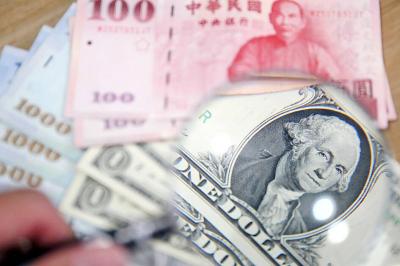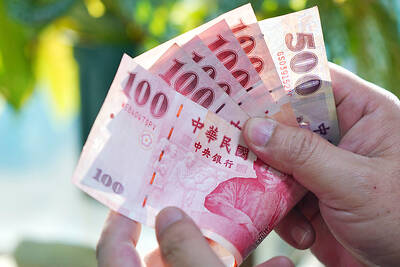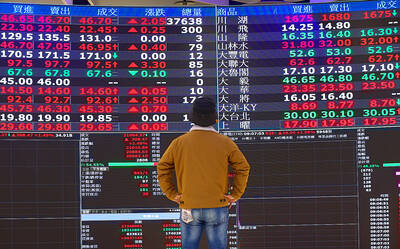US dockworkers agreed to end a three-day strike that had paralyzed trade on the US east and Gulf coasts and threatened to become a factor in the presidential election.
The International Longshoremen’s Association (ILA) and the US Maritime Association extended their previous contract through Jan. 15, the two groups said in a joint statement on Thursday. Work was set to resume yesterday morning. The two sides would also restart negotiations on a long-term agreement, which would include a pay increase of about 62 percent.
Fears of a sustained emergency swelled through the week, with analysts and industry officials warning that the disruption would quickly extend beyond the containerized imports, exports and autos impacted directly by the walkout. Estimates of the cost to the US economy ranged from US$3 billion to US$5 billion per day.

Photo: Bloomberg
“The strike is over,” ILA Local 333 president Scott Cowan told a CBS affiliate just after delivering the news to members gathered at the picket line outside the Port of Baltimore.
The agreement gives the ILA and USMX — as the group of terminal operators and shipping liners is known — time to resolve even more contentious issues without threatening the US economy just weeks ahead of the election. Shares of shipping lines in Asia fell as the suspension of the strike damped expectations that container rates would rise due to reduced capacity.
“We’re going to receive a 61.5 percent increase over the next six years and we’re going to have other language to protect us from automation worked out over the next few months, and other issues that we need resolved,” Cowan said.
Americans started to panic over potential shortages. Some anxious shoppers stocked up on goods, especially in areas affected by Hurricane Helene, which hit several southeastern states with flooding and power outages. One national grocery store chain set purchase limits on paper towels, toilet paper and water, adding to pressure on US President Joe Biden to intervene.
The deal neutralizes a potential political issue for the White House and the campaign of US Vice President Kamala Harris. A prolonged strike would have forced her to confront a crisis that fueled inflation.
It also spares Biden from having to put any public pressure on the ILA as he and Harris fight the Republican Party’s nominee, former US president Donald Trump, for the support of rank and file union members.
A deal, even a temporary one, means Biden would not have to decide whether to bear the political burden of a crippling strike or distance himself from the demands of the union.
Even though the strike lasted just three days, the cargo backlog is likely to take more than a month to clear, according to project44, a supply chain data company in Chicago. Port terminals began battening down the hatches days ahead and it would take them a while to fully reopen.
In the meantime, dozens of ships carrying containers and autos are anchored off the coast of major trade hubs in New York, South Carolina and Virginia, and would continue arriving faster than they can be unloaded.

The US dollar was trading at NT$29.7 at 10am today on the Taipei Foreign Exchange, as the New Taiwan dollar gained NT$1.364 from the previous close last week. The NT dollar continued to rise today, after surging 3.07 percent on Friday. After opening at NT$30.91, the NT dollar gained more than NT$1 in just 15 minutes, briefly passing the NT$30 mark. Before the US Department of the Treasury's semi-annual currency report came out, expectations that the NT dollar would keep rising were already building. The NT dollar on Friday closed at NT$31.064, up by NT$0.953 — a 3.07 percent single-day gain. Today,

‘SHORT TERM’: The local currency would likely remain strong in the near term, driven by anticipated US trade pressure, capital inflows and expectations of a US Fed rate cut The US dollar is expected to fall below NT$30 in the near term, as traders anticipate increased pressure from Washington for Taiwan to allow the New Taiwan dollar to appreciate, Cathay United Bank (國泰世華銀行) chief economist Lin Chi-chao (林啟超) said. Following a sharp drop in the greenback against the NT dollar on Friday, Lin told the Central News Agency that the local currency is likely to remain strong in the short term, driven in part by market psychology surrounding anticipated US policy pressure. On Friday, the US dollar fell NT$0.953, or 3.07 percent, closing at NT$31.064 — its lowest level since Jan.

The New Taiwan dollar and Taiwanese stocks surged on signs that trade tensions between the world’s top two economies might start easing and as US tech earnings boosted the outlook of the nation’s semiconductor exports. The NT dollar strengthened as much as 3.8 percent versus the US dollar to 30.815, the biggest intraday gain since January 2011, closing at NT$31.064. The benchmark TAIEX jumped 2.73 percent to outperform the region’s equity gauges. Outlook for global trade improved after China said it is assessing possible trade talks with the US, providing a boost for the nation’s currency and shares. As the NT dollar

The Financial Supervisory Commission (FSC) yesterday met with some of the nation’s largest insurance companies as a skyrocketing New Taiwan dollar piles pressure on their hundreds of billions of dollars in US bond investments. The commission has asked some life insurance firms, among the biggest Asian holders of US debt, to discuss how the rapidly strengthening NT dollar has impacted their operations, people familiar with the matter said. The meeting took place as the NT dollar jumped as much as 5 percent yesterday, its biggest intraday gain in more than three decades. The local currency surged as exporters rushed to